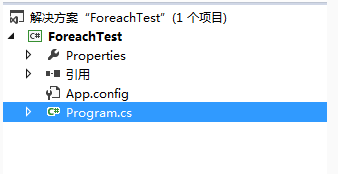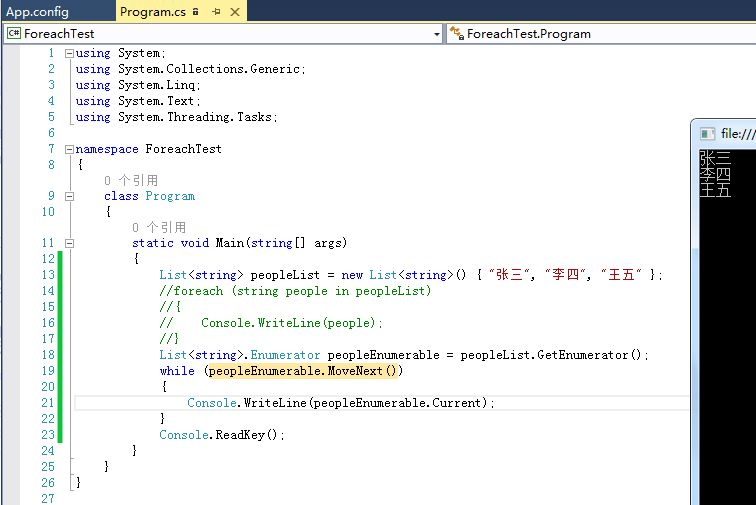C# Foreach循环本质与枚举器
对于C#里面的Foreach学过 语言的人都知道怎么用,但是其原理相信很多人和我一样都没有去深究。刚回顾泛型讲到枚举器让我联想到了Foreach的实现,所以进行一番探究,有什么不对或者错误的地方大家多多斧正。
1、创建一个控制台应用程序

2、编写测试代码并分析
在Program类中写一个foreach循环
class Program { static void Main(string[] args) { List peopleList = new List() { "张三", "李四", "王五" }; foreach (string people in peopleList) { Console.WriteLine(people); } Console.ReadKey(); } }
生成项目将项目编译后在debug目录下用Reflection反编译ForeachTest.exe程序集后查看Program类的IL代码,IL代码如下:

1 .class private auto ansi beforefieldinit Program 2 extends [mscorlib]System.Object 3 { 4 .method public hidebysig specialname rtspecialname instance void .ctor() cil managed 5 { 6 .maxstack 8 7 L_0000: ldarg.0 8 L_0001: call instance void [mscorlib]System.Object::.ctor() 9 L_0006: ret 10 } 11 12 .method private hidebysig static void Main(string[] args) cil managed 13 { 14 .entrypoint 15 .maxstack 2 16 .locals init ( 17 [0] class [mscorlib]System.Collections.Generic.List`1<string> list, 18 [1] string str, 19 [2] class [mscorlib]System.Collections.Generic.List`1<string> list2, 20 [3] valuetype [mscorlib]System.Collections.Generic.List`1/Enumerator`0<string> enumerator, 21 [4] bool flag) 22 L_0000: nop 23 L_0001: newobj instance void [mscorlib]System.Collections.Generic.List`1<string>::.ctor() 24 L_0006: stloc.2 25 L_0007: ldloc.2 26 L_0008: ldstr "\u5f20\u4e09" 27 L_000d: callvirt instance void [mscorlib]System.Collections.Generic.List`1<string>::Add(!0) 28 L_0012: nop 29 L_0013: ldloc.2 30 L_0014: ldstr "\u674e\u56db" 31 L_0019: callvirt instance void [mscorlib]System.Collections.Generic.List`1<string>::Add(!0) 32 L_001e: nop 33 L_001f: ldloc.2 34 L_0020: ldstr "\u738b\u4e94" 35 L_0025: callvirt instance void [mscorlib]System.Collections.Generic.List`1<string>::Add(!0) 36 L_002a: nop 37 L_002b: ldloc.2 38 L_002c: stloc.0 39 L_002d: nop 40 L_002e: ldloc.0 41 L_002f: callvirt instance valuetype [mscorlib]System.Collections.Generic.List`1/Enumerator`0<!0> [mscorlib]System.Collections.Generic.List`1<string>::GetEnumerator() 42 L_0034: stloc.3 43 L_0035: br.s L_0048 44 L_0037: ldloca.s enumerator 45 L_0039: call instance !0 [mscorlib]System.Collections.Generic.List`1/Enumerator`0<string>::get_Current() 46 L_003e: stloc.1 47 L_003f: nop 48 L_0040: ldloc.1 49 L_0041: call void [mscorlib]System.Console::WriteLine(string) 50 L_0046: nop 51 L_0047: nop 52 L_0048: ldloca.s enumerator 53 L_004a: call instance bool [mscorlib]System.Collections.Generic.List`1/Enumerator`0<string>::MoveNext() 54 L_004f: stloc.s flag 55 L_0051: ldloc.s flag 56 L_0053: brtrue.s L_0037 57 L_0055: leave.s L_0066 58 L_0057: ldloca.s enumerator 59 L_0059: constrained. [mscorlib]System.Collections.Generic.List`1/Enumerator`0<string> 60 L_005f: callvirt instance void [mscorlib]System.IDisposable::Dispose() 61 L_0064: nop 62 L_0065: endfinally 63 L_0066: nop 64 L_0067: call valuetype [mscorlib]System.ConsoleKeyInfo [mscorlib]System.Console::ReadKey() 65 L_006c: pop 66 L_006d: ret 67 .try L_0035 to L_0057 finally handler L_0057 to L_0066 68 } 69 }
在反编译的IL代码中我们看到除了构建List和其他输出,然后多了三个方法:GetEnumerator(),get_Current() ,MoveNext() ,于是通过反编译reflector查看List泛型类,在List里面找到GetEnumerator方法是继承自接口IEnumerable 的方法,List实现的GetEnumerator方法代码
public Enumerator GetEnumerator() => new Enumerator((List) this);
即返回一个Enumerator泛型类,然后传入的参数是List泛型自己 this。接下来查看 Enumerator<T>泛型类
[Serializable, StructLayout(LayoutKind.Sequential)] public struct Enumerator : IEnumerator<T>, IDisposable, IEnumerator { private List<T> list; private int index; private int version; private T current; internal Enumerator(List<T> list) { this.list = list; this.index = 0; this.version = list._version; this.current = default(T); } public void Dispose() { } public bool MoveNext() { List<T> list = this.list; if ((this.version == list._version) && (this.index < list._size)) { this.current = list._items[this.index]; this.index++; return true; } return this.MoveNextRare(); } private bool MoveNextRare() { if (this.version != this.list._version) { ThrowHelper.ThrowInvalidOperationException(ExceptionResource.InvalidOperation_EnumFailedVersion); } this.index = this.list._size + 1; this.current = default(T); return false; } public T Current => this.current; object IEnumerator.Current { get { if ((this.index == 0) || (this.index == (this.list._size + 1))) { ThrowHelper.ThrowInvalidOperationException(ExceptionResource.InvalidOperation_EnumOpCantHappen); } return this.Current; } } void IEnumerator.Reset() { if (this.version != this.list._version) { ThrowHelper.ThrowInvalidOperationException(ExceptionResource.InvalidOperation_EnumFailedVersion); } this.index = 0; this.current = default(T); } }
我们看到这个Enumerator<T>泛型类实现了接口IEnumerator的方法,也就是我们测试的ForeachTest程序集反编译后IL代码中出现的get_Current() ,MoveNext() 方法。所以foreach实际上是编译器编译后先调用GetEnumerator方法返回Enumerator的实例,这个实例即是一个枚举器实例。通过MoveNext方法移动下标来查找下一个list元素,get_Current方法获取当前查找到的元素,Reset方法是重置list。
3、总结
因此要使用Foreach遍历的对象是继承了IEnumerable接口然后实现GetEnumerator方法。返回的实体对象需要继承IEnumerator接口并实现相应的方法遍历对象。因此Foreach的另一种写法如下。

作者:孙泉
出处:https://www.cnblogs.com/SunSpring/p/9829298.html
如果你喜欢文章欢迎点击推荐,你的鼓励对我很有用!
本文版权归作者所有,转载需在文章页面明显位置给出原文链接。




【推荐】国内首个AI IDE,深度理解中文开发场景,立即下载体验Trae
【推荐】编程新体验,更懂你的AI,立即体验豆包MarsCode编程助手
【推荐】抖音旗下AI助手豆包,你的智能百科全书,全免费不限次数
【推荐】轻量又高性能的 SSH 工具 IShell:AI 加持,快人一步
· 从 HTTP 原因短语缺失研究 HTTP/2 和 HTTP/3 的设计差异
· AI与.NET技术实操系列:向量存储与相似性搜索在 .NET 中的实现
· 基于Microsoft.Extensions.AI核心库实现RAG应用
· Linux系列:如何用heaptrack跟踪.NET程序的非托管内存泄露
· 开发者必知的日志记录最佳实践
· TypeScript + Deepseek 打造卜卦网站:技术与玄学的结合
· Manus的开源复刻OpenManus初探
· 写一个简单的SQL生成工具
· AI 智能体引爆开源社区「GitHub 热点速览」
· C#/.NET/.NET Core技术前沿周刊 | 第 29 期(2025年3.1-3.9)